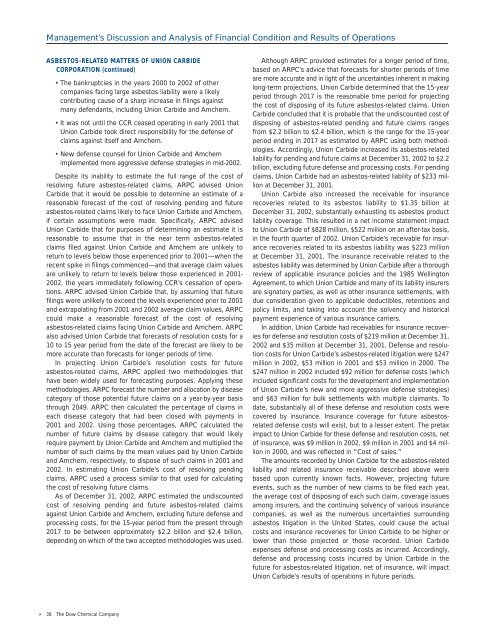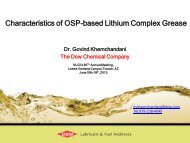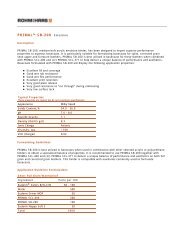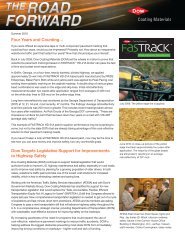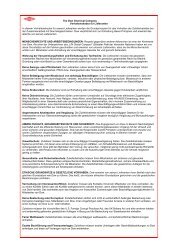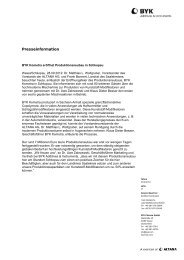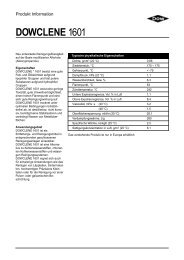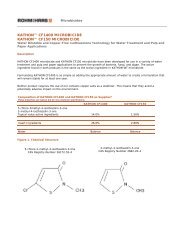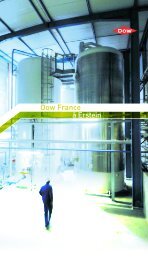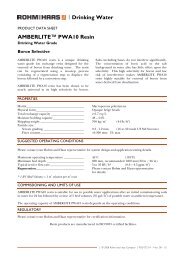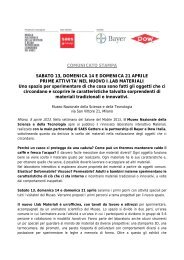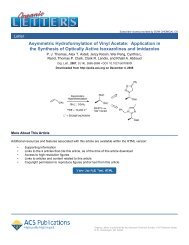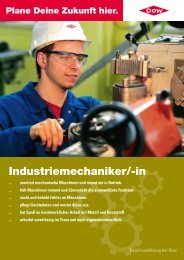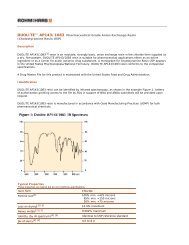Focus - The Dow Chemical Company
Focus - The Dow Chemical Company
Focus - The Dow Chemical Company
Create successful ePaper yourself
Turn your PDF publications into a flip-book with our unique Google optimized e-Paper software.
Management’s Discussion and Analysis of Financial Condition and Results of Operations<br />
ASBESTOS-RELATED MATTERS OF UNION CARBIDE<br />
CORPORATION (continued)<br />
• <strong>The</strong> bankruptcies in the years 2000 to 2002 of other<br />
companies facing large asbestos liability were a likely<br />
contributing cause of a sharp increase in filings against<br />
many defendants, including Union Carbide and Amchem.<br />
• It was not until the CCR ceased operating in early 2001 that<br />
Union Carbide took direct responsibility for the defense of<br />
claims against itself and Amchem.<br />
•New defense counsel for Union Carbide and Amchem<br />
implemented more aggressive defense strategies in mid-2002.<br />
Despite its inability to estimate the full range of the cost of<br />
resolving future asbestos-related claims, ARPC advised Union<br />
Carbide that it would be possible to determine an estimate of a<br />
reasonable forecast of the cost of resolving pending and future<br />
asbestos-related claims likely to face Union Carbide and Amchem,<br />
if certain assumptions were made. Specifically, ARPC advised<br />
Union Carbide that for purposes of determining an estimate it is<br />
reasonable to assume that in the near term asbestos-related<br />
claims filed against Union Carbide and Amchem are unlikely to<br />
return to levels below those experienced prior to 2001—when the<br />
recent spike in filings commenced—and that average claim values<br />
are unlikely to return to levels below those experienced in 2001-<br />
2002, the years immediately following CCR’s cessation of operations.<br />
ARPC advised Union Carbide that, by assuming that future<br />
filings were unlikely to exceed the levels experienced prior to 2001<br />
and extrapolating from 2001 and 2002 average claim values, ARPC<br />
could make a reasonable forecast of the cost of resolving<br />
asbestos-related claims facing Union Carbide and Amchem. ARPC<br />
also advised Union Carbide that forecasts of resolution costs for a<br />
10 to 15 year period from the date of the forecast are likely to be<br />
more accurate than forecasts for longer periods of time.<br />
In projecting Union Carbide’s resolution costs for future<br />
asbestos-related claims, ARPC applied two methodologies that<br />
have been widely used for forecasting purposes. Applying these<br />
methodologies, ARPC forecast the number and allocation by disease<br />
category of those potential future claims on a year-by-year basis<br />
through 2049. ARPC then calculated the percentage of claims in<br />
each disease category that had been closed with payments in<br />
2001 and 2002. Using those percentages, ARPC calculated the<br />
number of future claims by disease category that would likely<br />
require payment by Union Carbide and Amchem and multiplied the<br />
number of such claims by the mean values paid by Union Carbide<br />
and Amchem, respectively, to dispose of such claims in 2001 and<br />
2002. In estimating Union Carbide’s cost of resolving pending<br />
claims, ARPC used a process similar to that used for calculating<br />
the cost of resolving future claims.<br />
As of December 31, 2002, ARPC estimated the undiscounted<br />
cost of resolving pending and future asbestos-related claims<br />
against Union Carbide and Amchem, excluding future defense and<br />
processing costs, for the 15-year period from the present through<br />
2017 to be between approximately $2.2 billion and $2.4 billion,<br />
depending on which of the two accepted methodologies was used.<br />
> 38 <strong>The</strong> <strong>Dow</strong> <strong>Chemical</strong> <strong>Company</strong><br />
Although ARPC provided estimates for a longer period of time,<br />
based on ARPC’s advice that forecasts for shorter periods of time<br />
are more accurate and in light of the uncertainties inherent in making<br />
long-term projections, Union Carbide determined that the 15-year<br />
period through 2017 is the reasonable time period for projecting<br />
the cost of disposing of its future asbestos-related claims. Union<br />
Carbide concluded that it is probable that the undiscounted cost of<br />
disposing of asbestos-related pending and future claims ranges<br />
from $2.2 billion to $2.4 billion, which is the range for the 15-year<br />
period ending in 2017 as estimated by ARPC using both methodologies.<br />
Accordingly, Union Carbide increased its asbestos-related<br />
liability for pending and future claims at December 31, 2002 to $2.2<br />
billion, excluding future defense and processing costs. For pending<br />
claims, Union Carbide had an asbestos-related liability of $233 million<br />
at December 31, 2001.<br />
Union Carbide also increased the receivable for insurance<br />
recoveries related to its asbestos liability to $1.35 billion at<br />
December 31, 2002, substantially exhausting its asbestos product<br />
liability coverage. This resulted in a net income statement impact<br />
to Union Carbide of $828 million, $522 million on an after-tax basis,<br />
in the fourth quarter of 2002. Union Carbide’s receivable for insurance<br />
recoveries related to its asbestos liability was $223 million<br />
at December 31, 2001. <strong>The</strong> insurance receivable related to the<br />
asbestos liability was determined by Union Carbide after a thorough<br />
review of applicable insurance policies and the 1985 Wellington<br />
Agreement, to which Union Carbide and many of its liability insurers<br />
are signatory parties, as well as other insurance settlements, with<br />
due consideration given to applicable deductibles, retentions and<br />
policy limits, and taking into account the solvency and historical<br />
payment experience of various insurance carriers.<br />
In addition, Union Carbide had receivables for insurance recoveries<br />
for defense and resolution costs of $219 million at December 31,<br />
2002 and $35 million at December 31, 2001. Defense and resolution<br />
costs for Union Carbide’s asbestos-related litigation were $247<br />
million in 2002, $53 million in 2001 and $53 million in 2000. <strong>The</strong><br />
$247 million in 2002 included $92 million for defense costs (which<br />
included significant costs for the development and implementation<br />
of Union Carbide’s new and more aggressive defense strategies)<br />
and $63 million for bulk settlements with multiple claimants. To<br />
date, substantially all of these defense and resolution costs were<br />
covered by insurance. Insurance coverage for future asbestosrelated<br />
defense costs will exist, but to a lesser extent. <strong>The</strong> pretax<br />
impact to Union Carbide for these defense and resolution costs, net<br />
of insurance, was $9 million in 2002, $9 million in 2001 and $4 million<br />
in 2000, and was reflected in “Cost of sales.”<br />
<strong>The</strong> amounts recorded by Union Carbide for the asbestos-related<br />
liability and related insurance receivable described above were<br />
based upon currently known facts. However, projecting future<br />
events, such as the number of new claims to be filed each year,<br />
the average cost of disposing of each such claim, coverage issues<br />
among insurers, and the continuing solvency of various insurance<br />
companies, as well as the numerous uncertainties surrounding<br />
asbestos litigation in the United States, could cause the actual<br />
costs and insurance recoveries for Union Carbide to be higher or<br />
lower than those projected or those recorded. Union Carbide<br />
expenses defense and processing costs as incurred. Accordingly,<br />
defense and processing costs incurred by Union Carbide in the<br />
future for asbestos-related litigation, net of insurance, will impact<br />
Union Carbide’s results of operations in future periods.


